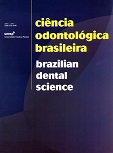Influence of condensation method and alloy type on mercury vapor release and residual porosity of dental amalgams
DOI:
https://doi.org/10.14295/bds.2004.v7i4.212Abstract
Objective: To verify the influence of condensation method and alloy type on mercury vapor emission and residual porosity of dental amalgams. Material and Methods: Three pre-dispensed amalgams were tested: one lathe-cut (F-4000), one spherical (Logic Plus) and one admixed (Permite-C). They were condensed in cylindrical cavities following three techniques: manual (Ward # 2), mechanical (Densco-Teledyne) and piezoelectric ultrasonic (Gnatus). Procedures were performed inside an acrylic box (50 x 50 x 35 cm, or 0.0875 m3) with an exhaustion pump (6 l/min). The level of mercury vapor was monitored during 15 min after trituration. Specimen’s porosity was assessed using metallographic polished surfaces, digitalized under 100x magnification. Results were submitted to ANOVA and Tukey’s test (p>0.05). Results: Significant differences were found in mercury vapor emission among alloys (p<0.01) and condensation techniques (p<0.01). The lathe-cut alloy produced significantly higher mercury vapor levels than the spherical alloy. The ultrasonic condensation led to significantly higher levels of mercury vapor than the other techniques. Residual porosity was not influenced by the type of alloy. The use of the ultrasonic device led to higher porosity in the amalgam than the other condensation techniques (p<0.05). Conclusion: Condensation method and alloy type influenced the mercury vapor release and residual porosity of dental amalgams.
Downloads
Downloads
Published
How to Cite
Issue
Section
License
Brazilian Dental Science uses the Creative Commons (CC-BY 4.0) license, thus preserving the integrity of articles in an open access environment. The journal allows the author to retain publishing rights without restrictions.
=================




























